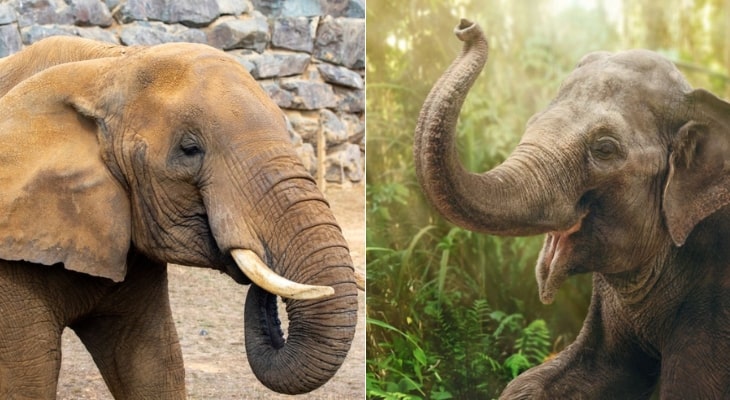
Sri Lanka is named the Pearl of the Indian Ocean, which embedding with vast biodiversity. According to the records, it is the 4th most popular destination for tourism in South Asia. The majority of the attractions are gain because of wildlife. Some giants come to mind when we talk about wildlife. In today’s world, they’re the stars.
According to local legends, elephants have lived in this area for thousands of years. It is considered a national symbol by the Sri Lankans. Aside from that, Sri Lanka is home to the world’s largest herd of rescued orphaned. Visit Sri Lanka if you have the chance to see these massive yet kind beasts, and you won’t regret it.
Elephant Categorization
There’s nothing quite like a good old-fashioned brawl between two elephants. Africa and Asiatic elephant (Elephas maximus) are the two most common species of elephants (Loxodonta). The African bush elephants/African savanna elephants and the African forest elephants are the two main types of African elephants (Loxodonta cyclotis).
The African forest elephant, which is smaller than the savanna elephant, lives in tropical rain forests. Each subspecies of the Asian elephant has its unique characteristics, such as the Sri Lankan, Indian, and Sumerian subspecies (Elephas maximus Sumatran) (Elephas maximus sumatranus).
Something more about Asian Elephants
Scientifically known as “Elephas maximus,” the Asian elephant can grow up to 3 feet and weigh 5,500 pounds. They are the largest animal on the Asian continent, with a length of up to ten meters. Thirteen countries in South and Southeast Asia are home to various habitats, from dry to wet.
They are living as smaller groups gathering up to 6-7 females leading by the oldest one. These groups hardly join with others to form larger herds, even although these communities are almost short-lived. It’s a well-known fact that Asian elephants are incredibly friendly. Females are more social than males. Usually, male ones living alone, but instead, they form small herds with other males.
Elephants usually are living near freshwater sources because they need to drink at least once a day. Averagely they need 150kg per day to survive. More than 2/3 of their day passes by feeding on tree barks, grasses, bushes, leaves, roots, and trim stems. But they love to eat cultivated foods like sugar cane, banana, and rice. Those are their favorite foods, but that is the most apparent reason for bringing them into conflict with humans. Asian elephants have adjusted to survive on resources that diversify based on the area.
Despite being the continent’s largest mammal, Asian elephants are much smaller than As a result; they have smaller ears than African species, which allows them to stay calm. Another difference is that Africans have a second finger on their lower lip, whereas the Europeans do not. Various skin tones range with pinkish spots on the forehead, ears, chest, and trunk’s base.
Male elephants, in particular, are missing their tusks. In Sri Lanka, 5 percent of males have ivory, while in southern India, 90 percent have ivory. It illustrates the ongoing ivory poaching in the past, anonymously.
Both male and female elephants become sexually mature around nine years old. But males do not start sexual activity until they become 14 to 15 years old, especially as most elephants reach their full size at about 17 yrs of age. In favorable habitat conditions, females give birth to a calf weight from 50-150kg once in 2.5 to 4 years. Several months later, the calf starting to eat grass and foliate. They grow under the supervision of their mother for some years at around four years of age until they make their first independent step.
Asian elephants are dividing into three subspecies: Indian, Sumatran, and Sri Lankan. They’re the smallest of the bunch. In terms of size and coloration, Sri Lankan tiger, As a result, Indian elephants have the most comprehensive range and are responsible for a significant portion.
Difference Between Asian Elephants and African Elephants
They’re easy to distinguish at a glance if you’re familiar with their distinctive features. There is no difference between the head and ears of Asian and African elephants. Additionally, several physical characteristics are easily distinguishable. Before that, it is better to have a clear visual of the differences between African savanna and forest elephants.
Many people think that they are two distinct species. But in 2000, scientists found and re-categorized the African elephant into an enormous African savanna elephant that sometimes designated the African bush elephant (Loxodonta africana) and the insignificantly more miniature African forest elephant (Loxodonta cyclotis).
Still, this is controversial whether they have many features to put them under two different species. Because as found, they have minimum physical and genetic differences. Both, however, differ in size and habitat while possessing far more distinguishing characteristics than Asian species.
We can distinguish them primarily based on ten physical traits.
- Head shape
- Size & Shape of the ears
- Size & weight
- Appearance & size of Tusks
- The appearance of the trunk
- The Shape of the Lower lip
- Skin texture
- Number of Toenails
- Number of ribs
- Teeth shape
In addition to these differences, Asian and African elephants have vastly different diets, ranges, and life spans.
Identification of Asian Elephants
- The center of their head has an imprint that runs from top to bottom.
- Have narrower semicircular ears that are using to disperse body heat.
- Its back is the tallest part of them all.
- A person’s maximum height as an adult is no more than 3.5 meters.
- The typical weight is between 3000 to 6,000 kilograms, which is lower than that of Africans.
- Female Asian elephants have rudimentary tusks called tushes, which can see in particular males, but only male Asian elephants have tusks.
- Tusks aren’t as big as Africans.
- The trunk has few rings and is difficult to touch.
- Has only one finger at the end of its trunk, which they compensate for by holding objects against the underside of their trunk.
- Lower lips are lengthy and constricted.
- Have a smoother complexion.
- The front foot has five missing nails, whereas the back foot has four.
- Have 20 pairs of ribs on average.
- All of the teeth on elephants are either pre-molars or molars. The tooth profile crush diamond-shaped.
- Food preference: grasses, bamboo, and palms over tree saplings.
- Life expectancy: up to 48 years.
- This species can be found in forested parts of Southern Asia, from Nepal to India and Sri Lanka. Myanmar, Malaysia, Thailand, Laos, and Cambodia, to name a few, are all located in Southeast Asia.
- The size of the herd has shrunk.
Identification of African Elephants
- They have a single dome-shaped structure on top of their heads, and their faces are rounder and more noticeable.
- To vent their body heat, they have significantly larger ears than before. Because they live in hotter settings with more intense sunshine, African elephants require more efficient heat transfer. As a result, the ears appear to be more prominent).
- Is tallest at the shoulder
- Bulls may reach a height of 4 meters.
- Have a weight range of 4,000 to 8,000 kg
- Elephants in Africa have tusks on both males and females.
- The size of the tusks is increasing.
- The trunk has more visible rings and is less brittle to the touch.
- The elephant’s trunk contains two separate “fingers” used to pick up and control objects.
- Lower lips are small and round;
- Skin is wrinkled due to larger crevices in the skin that hold water, which helps to keep the animals moist and prevent dehydration in their dry environments.
- African forest elephants have five front toenails and four back toenails, but African bush elephants have four front and three rear toenails.
- African elephants have more ribs than other elephants, with up to 21 pairs.
- The pre-molars and molars of the elephant are identical. Loxadont (or sloping) teeth give Africana Loxadonta its scientific name.
- Diet; act as ecological filters by breaking tree saplings and stripping them of their foliage,
- It estimated that elephants could live up to 70
- Lives in the rainforests of West and Central Africa and the savannas and deserts of Africa.
- The size of the herd is more important.
On each elephant’s foot, there are five toes. There are varying numbers of toenails on bush elephants, forest elephants in Africa, and Asian elephants.
Asian and African animals can’t live together in the same forest because their ranges do not intersect in any.
African and Asian elephants’ social relationships
- In all elephant species, women and their children live in herds with well-established social structures.
- Herds are matriarchal, with the eldest female leading the herd.
- When adolescent guys leave their family herds, a group of bachelor males is formed, and older males join these groups to become solitary as they get older.
More about Sri Lankan Elephants
Sri Lankan elephants are one of three subspecies of Asian elephants. Elephas maximus maximus is the largest Asian species and can find only in Sri Lanka (Linnaeus, 1758). Their ancestry is closely connecting to that slightly smaller than African species, SL species have a lot of other factors contributing to the demise of these species include fragmentation of their habitat, geographic contraction, and negative interactions with people
According to scientific reasons, they are genetically distinct from other members of their species. According to taxonomy, the Elephas maximus maximus is the scientific name for S Following is a breakdown of their scientific explanation.
- Kingdom -Animalia
- Class – Mammalia
- Order – Proboscidea
- Genus – Elephas
- Scientific name –
- Elephas Maximus
- Phylum -Chordata
- Family –
- Elephantidae
Elaphas comes from Greek and Latin roots, meaning antlered beast or colossal arch. According to the Latin phrase Maximus, they are the largest and most significant. In the Mammalia class, Elephantidae is a family that includes the subspecies.
On the continent, SL elephants are the largest animals. A fully developed adult animal stands 11.5 feet tall, roughly twice the height of a fully grown human. The range of body weight is 4,400 to 12,000 pounds. Male and female ones are often of different sizes. Males are typically 20% to 30% taller and weigh around twice as much as females of the same age.
It has tiny, angular ears with a lateral fold on the dorsal border. They have smoother, darker grey skin with more visible depigmentation spots on the species’ ears, face, trunk, and belly. The two bumps on their brows are a distinguishing feature of them. They, like all elephants, have a long and flexible trunk that can use for a variety of purposes. It is more rigid, with fewer rings, and at the end, a finger-like projection can be seen where it aids in shoveling tiny objects up.
Female Sri Lankan elephants never gain tusks ahead of short nubs. And also, about 5-10 percent of males grow up tusks. A Sri Lankan elephant reported tusks that measured 7.5 feet long. Raja was a nationally recognized animal in India who served a ceremonial role in a local religious center.
These fantastic creatures live primarily on the country’s southern coast, in the island’s tropical forests. Elephants are now more common in lowland areas such as valley dry deciduous forests, scrub, and surrounding pasture and cropland. Because they migrate by nature, they can sometimes be found in areas designated as protected parks and preserves.
Because of the dry and hot weather, these animals engage in various activities to regulate their body temperature. You may notice them constantly flapping their ears, covering their bodies with mud, and submerging themselves in water ponds. A healthy SL elephant can live between 55 and 70 years. These creatures live in herds led by the oldest female, the matriarch, and typically consist of 8-12 individual females and their offspring.
They usually travel together and share the responsibilities of caring for the children. When a male reaches sexual maturity, he leaves his herd and lives as an individual or temporarily bound with bachelor herds. All Asian elephants use several communication ways to engage with their clan members and potential mates. Cohesion is enforcing through a complicated communication system. Their lips and trunk produce different noises that they use to communicate over short and long distances.
With a variety of visual clues, the vocalizations range from low grumbling to high-pitched screams and trumpets. Due to their low frequency, their rumbling, growling, bellowing, and moaning sounds could carry a long distance. Many glands communicate by rubbing their trunks together and sending chemical signals.
These herbivorous mammals travel hundreds of miles per day in search of food and water. An adult can consume 10% of their body weight or nearly 300 pounds of food in a single day. Over 100 plant varieties, including dozens of species used in human cultivation, have been identified by researchers as being part of their diet. They consume a variety of plant species, including grasses and leaves. Cacti and other climbing plants are eating.
They must spend nearly 12 hours a day, every day, searching for new feeding sites to satisfy their voracious appetites. Around 10 to 15 years old, both sexes of elephants are sexually mature; a female is ready to have a child between nine and twelve. She calved every 2 1/2 to 4 years. Consequently, she can have up to seven children over her lifetime. Males, on the other hand, do not mate until they are in their late teens or early twenties due of
During mating rituals, males compete for the most attractive mate, with females making the final selection. Reproduce can happen at any time of the year. It is governing by the hormonal states of the two (from September to October). Females enter oestrus every three months, marked by a brief estrus period of three to seven days during which they are eligible for mating. Males go through a similar hormonal phase known as musth, which significantly increases their mating potential.
It’s impossible to mate with her because her oestrus cycle ceases when she becomes pregnant. A Sri Lankan elephant’s gestation period can go up to 680 days, making it one of the longest (22 Months). A single calf (sometimes twins) weighs between 75-115kg (200-300 pounds) and stands between 2.5 and 3.5 feet. When her oestrus cycle sets in, she’ll be ready to mate while she’s still breastfeeding.
All of the cows in the herd’s nursing unit take care of the baby elephants. They help the mother raise her child. In terms of caring for or breastfeeding their children, males are less likely than females. Infants per day consume approximately 12 liters of milk. Cavalry calves must be feeding and subsequently weaned during the first two years within a year or two of becoming self-sufficient; weaned males will leave the herd and live alone or as a small group.
Most of the time, it’s the oldest and most famous males who get to breed. At their most sexually active and aggressive, bull elephants will breed. A distinctive feature of elephants is their tusks, which compare them to other creatures, which gives them an air of majesty. In the course of their lifetimes, their incisor teeth mature and grow up to roughly 6 feet in length, which there are fewer than 3% of tuskers in Sri Lanka.
Sri Lankan elephant tusks weigh about 35kg and are slimmer than those of other Asian elephants. According to a new study, only bulls have long tusks, whereas cows only have small ones concealed under their rashes. A single elephant’s incisor is all that’s left, and it’s replacing seven times over. With each additional pair of teeth the animal acquires, a new place is returning to. After using all of their teeth, they will starve to death.
One of Asia’s longest tuskers, Millangoda Raja, lived in Sri Lanka for many years before passing away at 70. During the Kandy Esala Perahera, he carried the Sacred Tooth Relic’s casket for about four decades. However, tuskers face a grave threat due to their high value.
Lifestyle Of Sri Lankan Elephants
It is common to see female elephants with their young. Rarely do you see a male pack? To support their mother, adult nursing females tend to the calves? In the wild, males are solitary and only come together to breed during mating season. Average height and weight are 8ft and 1800 Kg, respectively.
Since they need a lot of water throughout the day, they live close to water sources. As a result of their enormous size, these giants require a significant habitat and colors. They are still in danger, even though their habitat is vanishing.
During the day, these animals mostly sleep under the trees, but at night they are active. People believe that these giants have their graveyards near water sources, and they are going there when going to die. But the scientific truth is as they grow old, their teeth are also wasting. Due to the difficulty of consuming heavy, rigid branches, they migrate to places with grass and water.
Sri Lankan Elephant Population
As far back as we can remember, Sri Lanka was home to a large population of elephants. Sri Lanka’s wild elephant population was estimated at 19,500 at the turn of the 19th century. Sri Lanka had 5 879 elephants in 2011, including 1,107 births and 122 tuskers (giant elephants).
This subspecies, however, is estimated to have a population of between 2,500 and 4,000. There has been a population decline since colonization, and conservationists believe it will continue in the future. Research suggests that the species will become extinct within a few decades.
The distribution of elephant herds has also changed; previously, the population existed throughout the country, but land utilization for cultivation has pushed them into drier regions. “The remaining forests and national parks in Sri Lanka could hold 4,000-5,000 elephants,” according to the Department of Wildlife Conservation (DWLC). However, the most severe threat to wild elephants is the human-elephant conflict.
As a result, the protection of these priceless species requires at all times. For the first time, an albino elephant was spotted in Sri Lanka’s Yala National Park in 2004, marking one of 17 members of a herd. Albinism is an uncommon hereditary disorder that affects just a tiny percentage Melanin, the pigment that gives skin, hair, and eyes their color, is insufficient.
Several albino sightings have occurred in recent years. However, tourists who come to Sri Lanka can get a memorable and fantastic experience with these giants. They can photograph while enjoying watching them and can even have a back ride in some places.
SRI LANKAN ELEPAHANTS FACTS
- Main Prey – Grass, Fruit, Roots
- Distinctive Feature – A lengthy trunk and large feet
- Diet – Herbivore
- Fun Fact -World’s most significant, most endangered species of animal
- Habitat – Rainforest and tropical woodland
- Lifestyle – Herd
- Favorite Food – Grass
- Type – Mammal
- Slogan – It’s now only allowed in a few parks.
- Predators – Human, Tiger
Massive Proportions: They weigh more than 10,000 pounds and can grow to about ten feet in height, making them the tallest subspecies in Asia.
Tusk Rarity: In comparison to other elephant species, Sri Lankan elephants have very few tusks. They’re fully developing in only a tiny fraction of adult males.
Small Range: Although these animals are enormous, their natural geographic range restricts them to a few isolated regions.
Big Appetite: To maintain their massive bulk, they must consume hundreds of pounds of food each day.
Elephants And Human Conflicts In Sri Lanka
In Sri Lanka, elephants and human conflicts is one of the world’s most severe environmental and socioeconomic concerns. Crop and property damage totals more than $10 million every year. In exchange, more than 100 elephants’ lives were lost. Sri Lanka is home to 10-20% of the region’s elephants. These enormous creatures necessitate much habitat space because they require large amounts of food and water to keep their massive bodies comfortable.
An average adult elephant requires a land area of five square kilometers to live in harmony with the environment. According to estimates, elephants occupy 17,500 square kilometers or 27% of the total land area. Protected areas in Sri Lanka, on the other hand, account for only 12.5 percent of the total land area of the country (or 8,200 km2). As a result, natural parks and reserves cannot ensure these creatures’ long-term survival, and long-term solutions are required.
Sri Lanka’s habitats are being degraded, fragmented, and lost due to deforestation for human settlements and cropping. While their numbers are increasing, wilder elephants are becoming a source of contention with humans. As food and water become scarce, they are forcing to eat cultivated foods to survive. Droughts, floods, and other climate-related incidents are also escalating the conflict in Sri Lanka.
With their massive size and large appetites, elephants can swiftly destroy the entire cultivation in a single night. Therefore the farmers see the elephant as a dangerous pest and would rarely regret its disappearance from their area. Thus this conflict has become the most severe conservation dilemma challenging the Department of Wildlife Conservation.
Yearly about 120 elephants are killed by humans for many reasons. Mainly they do this to protect their cultivations and houses, but few are killing them for ivory hunting. However, in return, about 65 people are attacked by elephants. In some years, these numbers have gone high as the crisis became a danger.
According to the DWLC, at least 1,369 elephants have died due to crop-raiding in the last decade. Five hundred and thirty-six people died in the same period; this human-elephant conflict is exacerbating by the elephant’s preference for sugarcane, bananas, and other fruits.
Elephants were subjected to a variety of unfortunate circumstances in the past. During the British occupation, Major Thomas Rogers, also known as “1400 & lost count,” is the main reason for slaughtering over 1400 elephants, including more than 60 tuskers. At least one jumbo per day until a lightning strike killed him. Major Thomas Skinner and Captain Galway shot over 600 and 700 jumbos during the same period, respectively.
As a result, we may assume that a lack of food for elephants is the fundamental cause of this conflict. Some possible explanations for what’s going on are as follows;
- Reduced forest area as a result of development work.
- The destruction of the forests.
- Villagers are intruding into the woods.
- Farmers’ cattle use grasslands.
- Forest quality is poor.
Elephant Slavery And Stop Cruelty
Elephants were domesticated in Sri Lanka for thousands of years. Sinhalese Kings held them captive for military purposes, enhancing the majesty of their reigns back in time.
In Sri Lanka, most elephants are now using for ceremonial purposes. It is uncommon to use for hauling and heavy labor. However, they are working on transporting steel, sand, and other building materials in a few cases. The Captive Elephant Owners Association was founded in 1998 to bring owners together to discuss Sri Lanka’s domesticated elephant’s face.
On the other hand, domesticated elephants are currently engaged in various activities that bring glory and wealth to the country.
1. Ceremonies and Temple Work: Elephants are frequently seen in Buddhist temple peraheras (processions). They dress up in bright colors and wear exquisite clothing to attend festivals. The most important event is the “Kandy Esala Perahera,” hosted by the Temple of the Tooth Relic. In a great tone, a large number of decked elephants march along. The precious tooth relic carries by the longest tusker. This opportunity is a once-in-a-lifetime for only a few tuskers.
2. Tourism: Elephants are used to provide tourists with rides. The National Zoological Gardens’ elephant orphanage near Pinnawala is another tourist attraction.
3. Construction: Throughout history, elephants have played an essential role in constructing ancient historical cities. Steel, sand, and other building materials can still be transported on elephants today.
4. Logging: especially in forested areas.
Due to the many scenarios that elephants face, authorities have solved them by taking conservative measures. Here are a few that are currently in the works.
- Elephant Deterrence – using noise, flashes, and other shock tactics to deter elephants from attacking.
- Founding of new National Parks and expanding the size of conservation areas.
- Establish elephant corridors – to allow the safe passage of elephants from one habitat site to another.
- Habitat endowment of elephant areas to heighten carry capacity
- Translocation of elephants to less populated areas
- Electrical Fencing – farmland and elephant habitat by erecting solid barriers
- Ex-situ conservation and breeding program
- Control poaching
- Synergizing elephant conservation with economic development.
Elephant Highlights Pinnawala Elephant Orphanage
Highlights of the elephant orphanage of pinnawala is a well-known tourist attraction in Sri Lanka. It has become the home for about 93 elephants and cares for most orphaned or abandoned newborn elephants in the wild.
Wildlife built the orphanage in 1975 on a 25-acre coconut farm on the Maha Oya River near Rambukkana. On February 16, 1975, the late Hon Minister Kalugalle put the concept into action. At first, the purpose is to give a safe and secure environment to care for baby elephants who lost their mothers. There were five abandoned babies, namely Vijaya, Neela, Kadira, Mathlete, and Kumari, on the premises when it starts.
The tragedy with these is they can not survive alone without their guardians until 4years of age. Most of them lost their mother just because they killed, died, or the baby had fallen into a pit. Not only for abandoned, orphanage caters to the injured and disabled within the jungle. They use both contemporary veterinarians and traditional indigenous medical expertise to care for these elephants.
Before relocation to the Bentota Tourist Complex and the Dehiwala Zoo, this orphanage was situated in Wilpattu National Park. Then it moved from the Zoo to Pinnawala. It converted into an orphanage at the time. In 1978, the National Zoological Gardens took over the Pinnawala Elephant Orphanage from the Department of Wildlife, and in 1982, it began a captive breeding program. In 1984, the orphanage made a considerable achievement by giving birth to a baby elephant on the premises, proving that breeding was possible.
Visitors, both domestic and foreign, were expected to use this facility to support the orphanage. On weekdays, it’s open from 8:30 am to 5:30 pm; on weekends, you should visit during feeding times, when you may watch the baby elephants are bottle-feeding. A nearby river is also a good spot for seeing the elephants bathe. In the entire world, there are only a handful of elephant orphanages. Pinnawala Elephant Orphanage, one of the most successful orphanages globally, is well-known around the world.
People are drawing on these fascinating creatures all over the world. A daily pleasure is walking down to the river and bathing the orphaned elephants in the water. An entire herd is racing around and tumbling in the river only a few steps in front of you. Any wildlife enthusiast visiting Sri Lanka should pay a visit to the Pinnawala Elephant Orphanage. Orphaned elephants provided medical care and food at the Pinnawala Elephant Orphanage, which helps reduce the Human-Elephant Conflict.
How to reach by public transport?
Take the Colombo-Kandy A1 road to get there. To get there, turn off 82 kilometers later at the Karandupana crossroads, and then take the Rambukkana bus and get out in front of the orphanage.
How can I get there by train?
Approximately 2 kilometers from Pinnawala, in Rambukkana, which has a train station. To get to Rambukkana from the Colombo-Kandy railway line, follow the signs. Getting on the Kegalle bus and exiting in front of the PEO might be helpful.
Yala (Ruhuna) National Park Elephant Sri Lanka
National Park Ruhuna, also known as Yala National Park or Ruhuna National Park, is a protected area in Sri Lanka’s south. It is Sri Lanka’s most visited and second-largest national park. The park is divided into two portions and is located in the Hambantota and Monaragala districts of Uva province. The park is 979 square kilometers and is about 300 kilometers (190 miles) from Colombo (378 sq. mi).
Yala is a vital wildlife sanctuary reserved in 1900 for Sri Lankan elephants, leopards, and aquatic birds. As a result, the park is noticing for its diverse collection of wild animals.
You may witness a large number of newborn elephants and herds strolling through Yala if you visit. Females frequently live in groups. Male herds, on the other hand, have been spotted in Yala. The most significant time to see elephants is during the dry season, which lasts from May to August. Yala’s elephant herd is made up of 300–350 elephants.
The park’s elephant population changes with the seasons. Yala is home to several endangered species, including elephants. Lunugamvehera National Park, which is close by, links Yala and Uda Walwe National Parks. Tourists visiting Sri Lanka, on the other hand, are primarily interested in seeing elephants. There are several locations where people might have remarkable experiences on their journey.
They adore photographing, watching, and even horseback riding. Yala, Minneriya, Kaudulla, Wasgamuwa, Wilpattu, Gal Oya, Udawalawe, and Lahugala Kitulana National Parks are among the best places in Sri Lanka to see these renowned wild giants. Elephant back safaris are more common in Minneriya, Kaudulla, Udawalawe, and Yala.
The Elephant Transit Home in Udawalawe National Park is another excellent spot to see elephants. Orphaned elephant infants are rehabilitated and released into the jungle around here, where they grow strong enough to survive in their natural habitat.
Conclusion : Sri Lankan Elephants | Asian & African Elephants
Elephants are a recognizable symbol of Sri Lanka. Sri Lanka has over ten times the population of Asian elephants than any other country. They have become a cultural icon in Sri Lanka, yet they are restricting to its dry zone. In the Adam’s Peak area, a tiny herd of elephants lives, and these are the last forest-dwelling elephants in Sri Lanka’s wet zone.
Due to habitat destruction and human-elephant conflict, this charismatic species is losing its niche. Clearing for human settlements and developing agriculture in Sri Lanka is fragmenting the big blocks of trees they require. Human-elephant conflicts are on the rise, resulting in property devastation and the deaths of both humans and elephants.
According to current mortality rates, approximately 6% of wild animals die each year. As a result, several conservation techniques are requiring to protect the endangered elephant Elephas maximus throughout its range.







